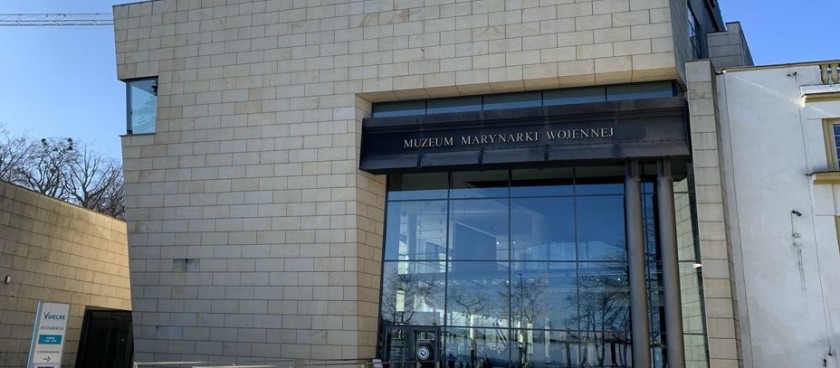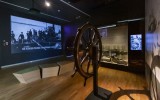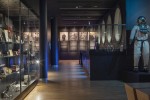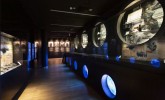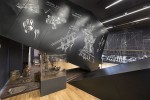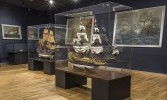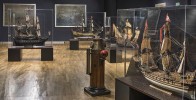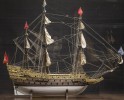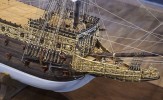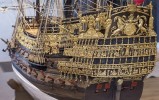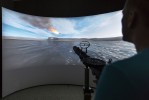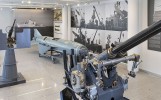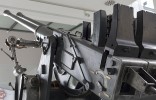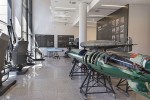- #PL46
- Zawiszy Czarnego 1B, 81-374 Gdynia, Poland
- +48586201381
- promocja@muzeummw.pl
- http://www.muzeummw.pl/
- Working hours*:
09 - 17 - Prices*:
Adult 20 zł
Child (7-16 yrs) 12 zł
Concession* 12 zł
Family ticket 2+2 56 zł
Group tickets adult (minimum 10 adults) 15 zł p/p.
Group tickets child/concession (minimum 10 children / concession) 10 zł p/p. - * - opening and closing times as well as entrance prices, are subject to alterations without notice. Visitors are advised to check before visiting.
- 54.5158988, 18.5477223 Copy to clipboard Copy
-
#Family time , #Museums , #Marines
The Naval Museum has already become a part of Gdynia’s landscape. It is hard to imagine Kościuszko Square without ORP BŁYSKAWICA‘s beautiful silhouette or the Seaside Boulevard (Bulwar Nadmorski) without the Museum’s naval weaponry outdoor exhibition. The Naval Museum is a permanent institution in the service of the community and of its development. It is open to the public. The Museum acquires, conserves, researches and exhibits, the physical evidence of the history of the Polish Navy, for the purposes of study, education and enjoyment. One of our main aims is to be able to make the history of the Polish Navy more accessible to all.
Our exhibitions present the story of the Polish naval forces that everyone, who is interested in the history of Polish presence on the seas, can enjoy.
The large number of visitors to our Museum has proved its popularity and keen interest in the Polish Navy history. It also assures us that we can continue our work at the Naval Museum and increase our efforts. The growing reputation of the Museum also means that more and more priceless exhibits come to this institution, thus enriching our naval collection.
EXHIBITIONS OF THE NAVAL MUSEUM
“It’s our sworn duty to defend you…” – a modern new permanent exposition
Exactly on the one hundredth anniversary of this event, on the 28th of November 2018 our Naval Museum opened its new permanent exhibition.
With the fall of the old Imperial Powers in 1918, Poland regained her independence after 123 years and came back on the European map as a sovereign country. Poles who until then were serving in foreign armies under the banners of Russia, Austria-Hungary and Kaiser’s Germany, now came to help fill the ranks in the newly emerging Polish Navy, fighting for Poland’s new borders and to keep her just regained independence.
The creation of the navy started immediately after Poland regained her independence. It had to be created from nothing; the staff structure built, men trained, navy schools set up, vessels bought or built, ports and shipyards were yet to be built. Even the Polish identity, divided between three occupants for over a hundred years, had to be rebuilt and again unified. A new tradition of the Polish naval ensign was in the making.
Then, there came the time of the trials by fire in WW2 and the enigmatic “great days of the small fleet” soon followed by the post-war disappointment. The horrendous period of Stalinist repressions but at the same time many years and generations of recording the history and exploits of Polish ships and their crews. Finally, the last stage – joining the free world again, entering the North Atlantic Treaty Organization (NATO), the most powerful military alliance in the world. New perspectives, new challenges but also problems linked to the urgent need to modernise the army.
All this is presented in an enforced summary in our new exposition, which we would gladly multiply in size many times over, to be able to fully make use the content of our collections stored in the museum’s archives and storerooms. The display combines the modernity of contemporary interior design & multimedia, with the museum classic of solid artefacts. You can see our most precious objects and memorabilia belonging to the creators of the Polish Navy, to our Navy’s war heroes, to the ships, to the victories and to the dramas – the story of the Navy’s ships and people.
It’s one hundred years of the Polish Naval history in one place.
The world of old ships
The date of 28th November 1627 is very significant for Polish marine history. It is the date of Battle of Oliva. The naval Battle of Oliva took place during the Polish-Swedish War outside Gdańsk harbour near Oliwa village. It was the biggest and the last naval battle of the Polish royal navy, which brought it a victory over a Swedish squadron. On the display in our museum we present the models of the main ships that fought in this memorable battle.
The collection “From the Cog to the Galleon” shows main types of sailing ships which dominated the seas of northern Europe. From the cog or hulk (a type of medieval sea craft) to “Peter of Gdańsk” (Peter von Danzig) – a carrack erroneously called a “great caravel”. At the time it was the largest ship in the Baltic Sea. In one of its naval battles the spoils of war included the famous painting by Hans Memling “The Last Judgement” was later offered to the St. Mary’s Church in Gdańsk. The pride of the collection is a model of stately yacht/galley which was made probably in early 18th century for King August II the Strong.
The exhibition is greatly enriched by the paintings of one of the greatest Polish marine painters – Marian Mokwa. In the greater part of this work, the artist focuses on the Polish sea, its ships, people and history. He created a series of historical paintings entitled “The Apotheosis of Marine Poland”. The 2nd World War brought significant damage to the artist’s works with most of “The Apotheosis” destroyed and many others paintings looted by German invaders in 1939. The paintings brought together for this display are part of the collection that was recreated after the war and show ships from the same period as most of the displayed models. Two of the largest paintings depict scenes from the Battle of Oliva.
The collection of most famous sailing ship models includes Christopher Columbus’s flagship Santa Maria, Lord Nelson’s flagship at the Battle of Trafalgar in 1805 – a 104-gun first-rate ship of the Royal Navy – HMS Victory, and another first-rate warship of the English Royal Navy – Sovereign of the Seas. She was the most extravagantly decorated warship in the Royal Navy, completely adorned from stern to bow with gilded carvings. There’s also a model of a classic clipper, the superior speed of this type ships compared to other ships, is still legendary today.
The exhibition is enriched with artefacts from the old sailing ships, such as original weapons and fighting equipment found on the decks: helmets from the 16th century, examples of small arms, firearms and ships cannonballs. Also on show are the navigational instruments from the period.
A true rarity of this exhibition is the original of Eilhard Lubinus’s great map of Western Pomerania, a unique and priceless work of cartography. It is also from the same period as the great sailing ships on display, which in those says ruled the seas.
A brief walk through the museum world of old sailing ships will let you feel into the specific roles played by these ships, which back then often decided the fate of countries and nations.
The naval museum armoury
Among the Naval Museum’s collection you can find some very unique objects, for example the Bofors 40mm double anti-aircraft gun from the ORP Sęp submarine (an identical gun was on Sęp’s twin sister ship ORP Orzeł). Then there is the most famous anti-aircraft (AA) gun of the WW2 – the 20mm Oerlikon on its marine mount. The one shown here was a part of the weaponry of the destroyer ORP Błyskawica. Next there is the incomplete 13.2mm Hotchkiss machine gun, salvaged from the ORP Gryf’s wreck. The ORP Gryf was bombed and sank in Hel in September 1939. Dramatically poignant is a torn part of the ship’s flag which includes a small part of the Polish Eagle, rescued from the sinking ship. Also saved were the brass letters of the ship’s name as well as an original lifebuoy.
The underwater weaponry is represented by a number of torpedoes. We would like to draw your attention to the C35/84 type torpedo produced in Germany from 1884. These torpedoes were in use at the turn of the 19th and 20th century. But one of the most precious artefacts is the French SM-5 naval moored-contact mine, which was used by the Polish Navy during the invasion of Poland by Germany in September 1939. On the 1 of October 1939 the German minesweeper “M 85” was sunk by one of them laid by the Wilk-class submarine ORP Żbik.
Among the weapons used to fight the enemy submarines, the QF MK IV Thornycroft Naval Gun is a perfect example. This British gun was the basic gun of the Royal Navy used to deploy naval depth charges from ships. It was one of these guns that was mounted on the ORP Błyskawica and ORP Grom. Besides the specimen in our museum there is another one on board of ORP Błyskawica.
